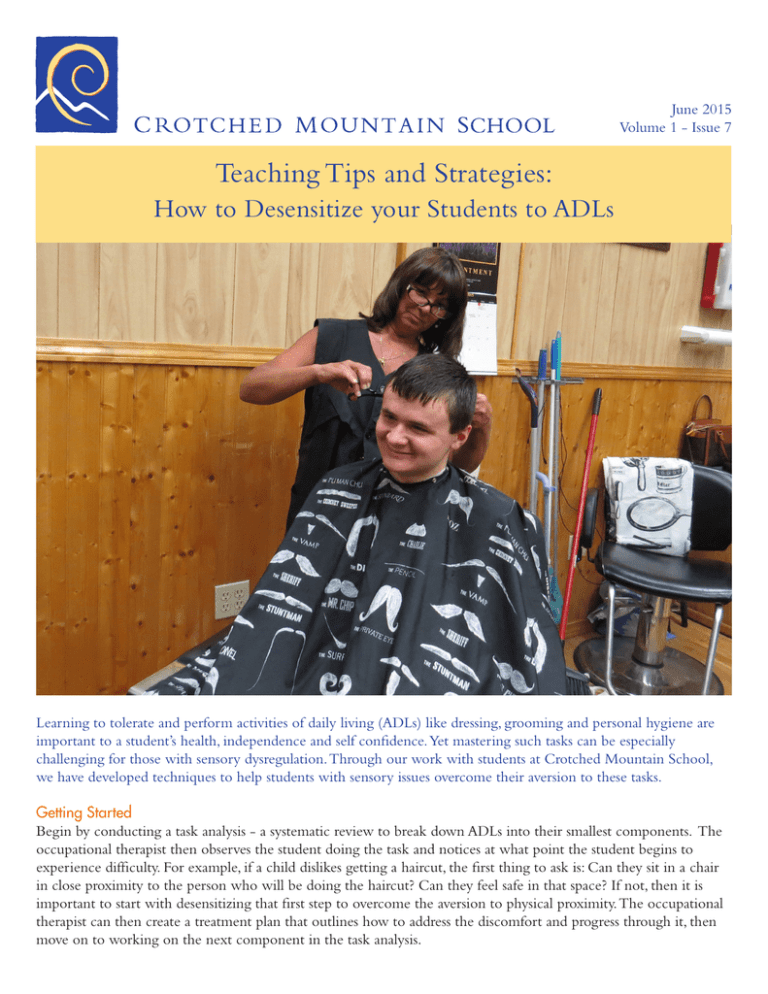Teaching Tips and Strategies:
advertisement

June 2015 Volume 1 - Issue 7 Teaching Tips and Strategies: How to Desensitize your Students to ADLs Learning to tolerate and perform activities of daily living (ADLs) like dressing, grooming and personal hygiene are important to a student’s health, independence and self confidence. Yet mastering such tasks can be especially challenging for those with sensory dysregulation. Through our work with students at Crotched Mountain School, we have developed techniques to help students with sensory issues overcome their aversion to these tasks. Getting Started Begin by conducting a task analysis - a systematic review to break down ADLs into their smallest components. The occupational therapist then observes the student doing the task and notices at what point the student begins to experience difficulty. For example, if a child dislikes getting a haircut, the first thing to ask is: Can they sit in a chair in close proximity to the person who will be doing the haircut? Can they feel safe in that space? If not, then it is important to start with desensitizing that first step to overcome the aversion to physical proximity. The occupational therapist can then create a treatment plan that outlines how to address the discomfort and progress through it, then move on to working on the next component in the task analysis. Communication If your student is verbal, it’s helpful to ask them about their sensitivities. What things or activities bother them the most? What are they scared of? What tasks do they need help with? Incorporating the student’s perspective, as well as those of parents and staff, is crucial to the therapy process. If a student is nonverbal, the therapist can pay attention to facial expressions, body language, vocalizations and other behavioral clues to determine when the student first becomes uncomfortable. It is also important to rule out any medical conditions that may impact the student’s performance. Developing a plan Once the occupational therapist has completed the assessment, an action plan is developed. This could include formal goals and objectives in an IEP, step-bystep ADL protocols for parents and staff to follow, as well as a treatment plan for the therapists themselves. To begin, it is most effective if the therapist is the only person to work on a specific ADL, since routine, structure and a student’s clear understanding of what to expect are important factors for comfort and success. Breaking down the process, step-by-step Start with a small, achievable goal. Nail clipping, for example, can feel like torture for someone with sensory issues. The feeling of having someone sitting in close proximity, the anticipation of nails being clipped and the pressure of the clippers on the nail can send the student into an autonomic fight or flight state. This need to protect oneself often results in a pattern of maladaptive behaviors. For nail clipping, it might be beneficial to simply sit for a few seconds with the nail clippers on the other side of the table without the student demonstrating any unsafe or avoidance behaviors. The moment the student manages this for the first time, reward, reward, reward! Repeat as many times as needed until the student has comfortably accomplished this goal. This may take one session, a few days or a few weeks. Progressing with small goals eases your student into the process and prevents a task from being overly intimidating or frightening. Practice and patience are key factors in desensitizing a student to ADLs. Taking it slow, keeping sessions consistent and rewarding every success are key factors in helping your student feel comfortable. Ultimately, this will move him or her one step closer to finding success and increased independence at school, at work and for years to come. Gwen Rumburg has worked at Crotched Mountain for 26 years, starting as a licensed nursing assistant and, for the past 14 years, as a licensed, registered occupational therapist for students aged 8 - 22. In addition to her work as a school OT, Gwen is the OT intern program coordinator and runs the Crotched Mountain Equine Collaborative. For more Teaching Tips and Strategies, visit www.cmf.org/tips David Etlinger, Director of Admissions admissions@crotchedmountain.org / 603.547.3311, ext. 1894 1Verney Drive, Greenfield, NH 03047 / www.cm-school.org Crotched Mountain School does not discriminate on the basis of race, color, age, gender, sexual orientation, religion, national origin or disability. Rev. 7/2015


